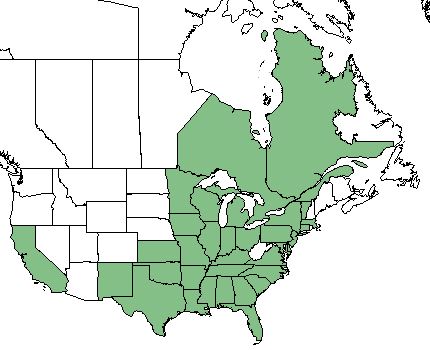Difference between revisions of "Monarda punctata"
(→Distribution) |
|||
| Line 38: | Line 38: | ||
<!--===Fire ecology===--> <!--Fire tolerance, fire dependence, adaptive fire responses--> | <!--===Fire ecology===--> <!--Fire tolerance, fire dependence, adaptive fire responses--> | ||
<!--===Pollination===--> | <!--===Pollination===--> | ||
| − | + | ||
| + | ===Use by animals=== <!--Herbivory, granivory, insect hosting, etc.--> | ||
| + | ''M. punctata'' composes 5-10% of the diets of large mammals.<ref name="Miller & Miller 1999">Miller JH, Miller KV (1999) Forest plants of the southeast and their wildlife uses. Southern Weed Science Society.</ref> | ||
<!--==Diseases and parasites==--> | <!--==Diseases and parasites==--> | ||
Revision as of 16:08, 29 January 2018
| Monarda punctata | |
|---|---|

| |
| Photo by John B | |
| Scientific classification | |
| Kingdom: | Plantae |
| Division: | Magnoliophyta - Flowering plants |
| Class: | Magnoliopsida - Dicots |
| Order: | Lamiales |
| Family: | Lamiaceae |
| Genus: | Monarda |
| Species: | M. punctata |
| Binomial name | |
| Monarda punctata L. | |

| |
| Natural range of Monarda punctata from USDA NRCS Plants Database. | |
Common Names: Arkansas horse mint; eastern horse-mint; hairy-stem horse mint;[1] spotted beebalm[2]
Contents
Taxonomic Notes
Varieties: M. punctata var. arkansana; M. punctata var. punctata; M. punctata var. villicaulis[1][2] M. punctata var. correllii; M. punctata var. coryi; M. punctata var. intermedia; M. punctata var. lasiodonta; M. punctata var. occidentalis[2]
Description
Monarda punctata is a dioecious species, classified as an annual, biennial, and perennial. It grows as a forb/herb or subshrub.[2]
Distribution
This species is found from New Mexico and Kansas, eastward to Florida, northward to Vermont and Massachusetts, and inland to Iowa and Minnesota. Exceptions to this are Delaware and West Virginia, where no mounted specimens have been reported to the USDA. It also occurs in the Canadian provinces of Ontario and Quebec and has a disjunct population in California.[2]
Ecology
Habitat
M. punctata occurs in dryish forests over mafic rock, maritime forests, dunes, roadsides, rocky or sandy woodlands, and disturbed areas.[1]
Phenology
In the southeastern and mid-Atlantic United States, flowering occurs from July through October.[1]
Use by animals
M. punctata composes 5-10% of the diets of large mammals.[3]
Conservation and Management
Cultivation and restoration
Photo Gallery
References and notes
- ↑ 1.0 1.1 1.2 1.3 Weakley AS (2015) Flora of the Southern and Mid-Atlantic States. Chapel Hill, NC: University of North Carolina Herbarium.
- ↑ 2.0 2.1 2.2 2.3 2.4 USDA NRCS (2016) The PLANTS Database (http://plants.usda.gov, 29 January 2018). National Plant Data Team, Greensboro, NC 27401-4901 USA.
- ↑ Miller JH, Miller KV (1999) Forest plants of the southeast and their wildlife uses. Southern Weed Science Society.